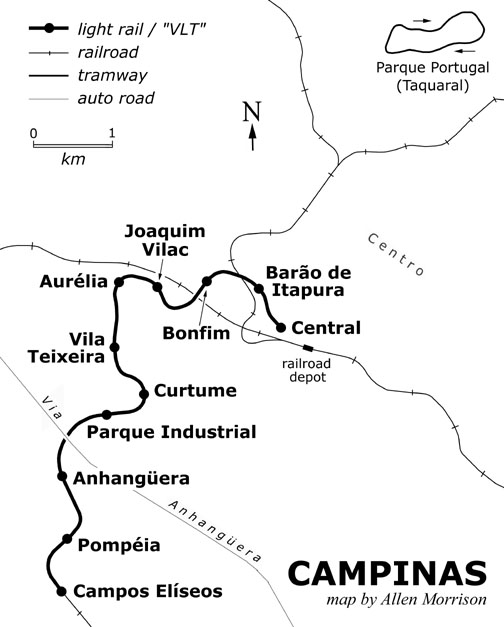The streetcar system in this city, 90 km north of São Paulo, closed in 1968. The mayor saved four trams and built a line for them around a lake in Parque Portugal [see map below and my webpage], which opened in 1972 and still runs today. The city's railroads also started closing during this period and in January 1990 FEPASA (Ferrovias Paulistas, S.A.), successor to the Sorocabana Railway, agreed to rebuild some of its urban rights-of-way as a "metrô de superfície" (surface metro) or light rail line.
Nine routes were planned and six articulated VLTs [see introduction] like those in Rio de Janeiro were ordered from Cobrasma in São Paulo. Construction began in June 1990 on a winding 8 km route between the railroad depot and Campos Elíseos. Eleven stations were built, the line was double-tracked and rail gauge was changed from 1000 to 1600 mm, the standard for rapid transit in Brazil.
Work progressed rapidly and in order to operate a segment before the spring elections local politicians borrowed two VLTs from Rio de Janeiro. The governor and his cohorts rode a 2-car train along a 2 km section of the city's new "metro", between Barão de Itapura and Aurélia stations, on 23 November 1990. The Rio cars returned to Rio in December and the new VLTs - numbered 5701 through 5706 - began arriving in January. These were allegedly from a lot that Cobrasma had built for Rio but not delivered, and were already equipped with high-level doors. The "light rail" line in Campinas, like that in Rio, was built with overhead wire and high-platform stations. Two VLTs began providing free rides for the public along a 4 km section between Central and Vila Teixeira on 9 March 1991. The remaining cars arrived soon after, but revenue service along the entire 8 km route to Campos Elíseos did not begin until 22 April 1993. I took the following 15 photographs on Saturday 16 April 1994: Three views at Central station An overpass near Barão de Itapura station A train leaving Aurélia station Three pictures at Parque Industrial station Four photos taken near Anhangüera station Three photos at Pompéia station The Campinas light rail line was beautifully built and more picturesque than the one in Rio. But the area that it served was thinly populated and the entrance to "Central" station was hard to find, hidden on a side street, separate from the railroad depot. The city center was still a mile away. According to a local newspaper, the line "ligou nada a lugar nenhum" - connected nothing to no place. Two VLTs passing every 15 minutes averaged only 5,000 passengers per day, whereas 100,000 were needed to pay expenses. Since the line was a state and not a city project, there was no integration with local bus routes. Plans for a new "rodoviária" (intercity bus terminal) near the Via Anhangüera highway - which would have generated enormous traffic - never materialized and the line carried its last passenger on 16 February 1995. Commercial operation had lasted less than two years. For a while the cars were run once a week to prevent corrosion. But eventually they were abandoned on the line, where they rotted and were vandalized. The wire was stolen and the right-of-way grew weeds. The stations were occupied by vagrants who sold drugs at the ticket booths. Two corpses were found in the booth at Campos Elíseos (Elysian Fields). Recently some of the stations have been reclaimed and occupied by railroad workers and their families. Later in 1997 the trains were transferred to a FEPASA yard in Jundiaí, 42 km south of Campinas, and later to the FEPASA shops in Rio Claro, 81 km northwest of Campinas, where Sergio Martire photographed car 5706 in May 2001: The only other city in the world that acquired VLTs like those in Rio de Janeiro and Campinas was Portland in Oregon state, USA. Portland purchased 26 cars from Bombardier, a Canadian company that had acquired the rights to the BN design. The Portland line opened in September 1986 and still operates the same cars today. This postcard view by Steve Morgan was taken in July 1985, when the line was still testing.
BIBLIOGRAPHY (in order of publication): "Campinas LRT will use FEPASA line." International Railway Journal (London), 9/1990, p. 18. Reinaldo de Andrade. "A volta do bonde em grande estilo." Transporte Moderno (São Paulo), 1/1991, pp. 4-6. "Campinas inaugura VLT e entra na era do metrô." Correio Popular (Campinas), 14/3/1991. "Prefeitura culpa a chuva e adia a operação comercial do metrô." Correio Popular (Campinas), 3/4/1991. João Ernesto Toppan Nogueira. "Converting to Light Rail." Railway Gazette International: Developing Metros (London), 5/1991, p. 29. "O primeiro em operação: VLT de Campinas" Revista Ferroviária (Rio de Janeiro), 10/1991, p. 12. "VLT deixa de operar a partir de amanhã." Correio Popular (Campinas), 16/2/1995, Cidades 1. "R$ 200 milhões apodrecem no VLT." Diário do Povo (Campinas), 1/8/1996, p. 1. "Prefeitura começa a privatizar VLT." Correio Popular (Campinas), 7/8/1996, p. 1. "Deputado vai pedir CPI para obras do VLT." Correio Popular (Campinas), 16/8/1997, Cidades 1. "Vagões do VLT enferrujam em Jundiaí." Correio Popular (Campinas), 7/9/1997. "Não podemos permitir esse crime." Jornal do Simionato (Campinas)m 10/1997, p. 3. Alexandre Delacqua. Campinas VLT. Pioneer Internet website uploaded 7/1998, now defunct.
|

